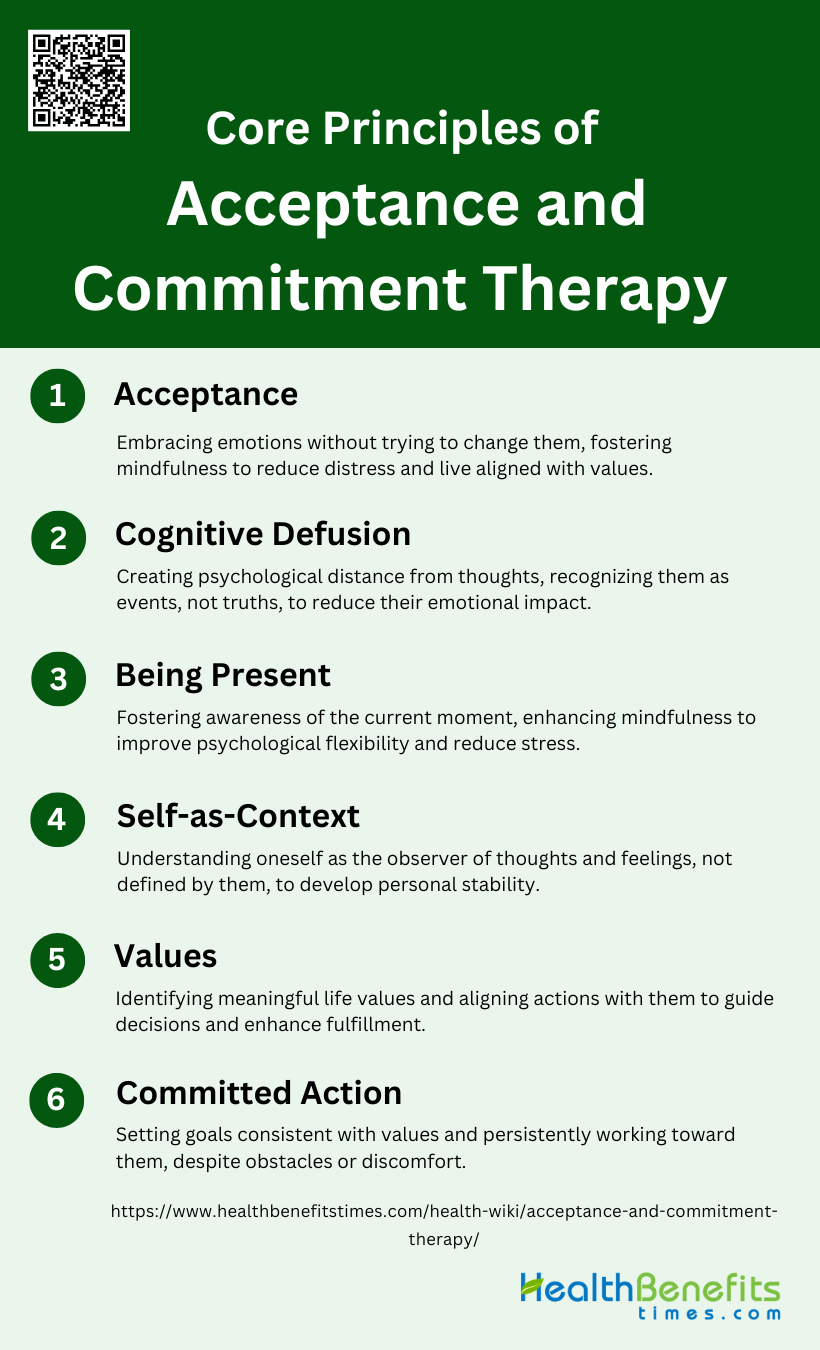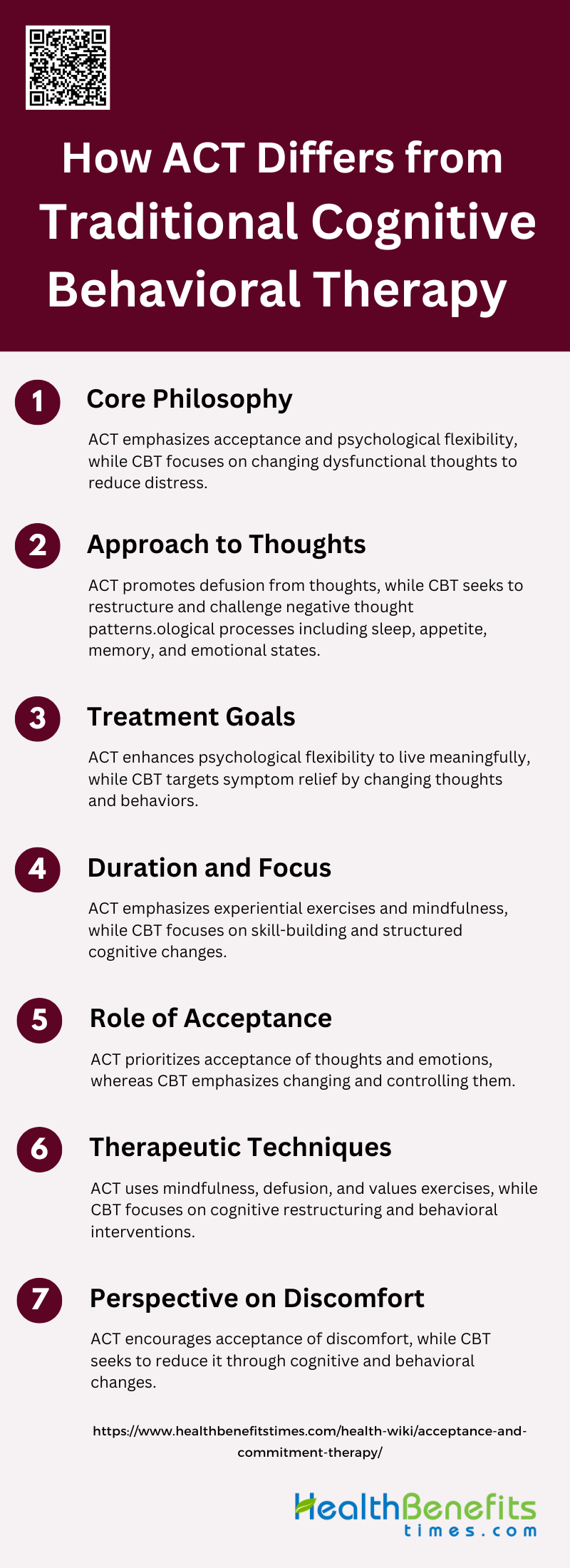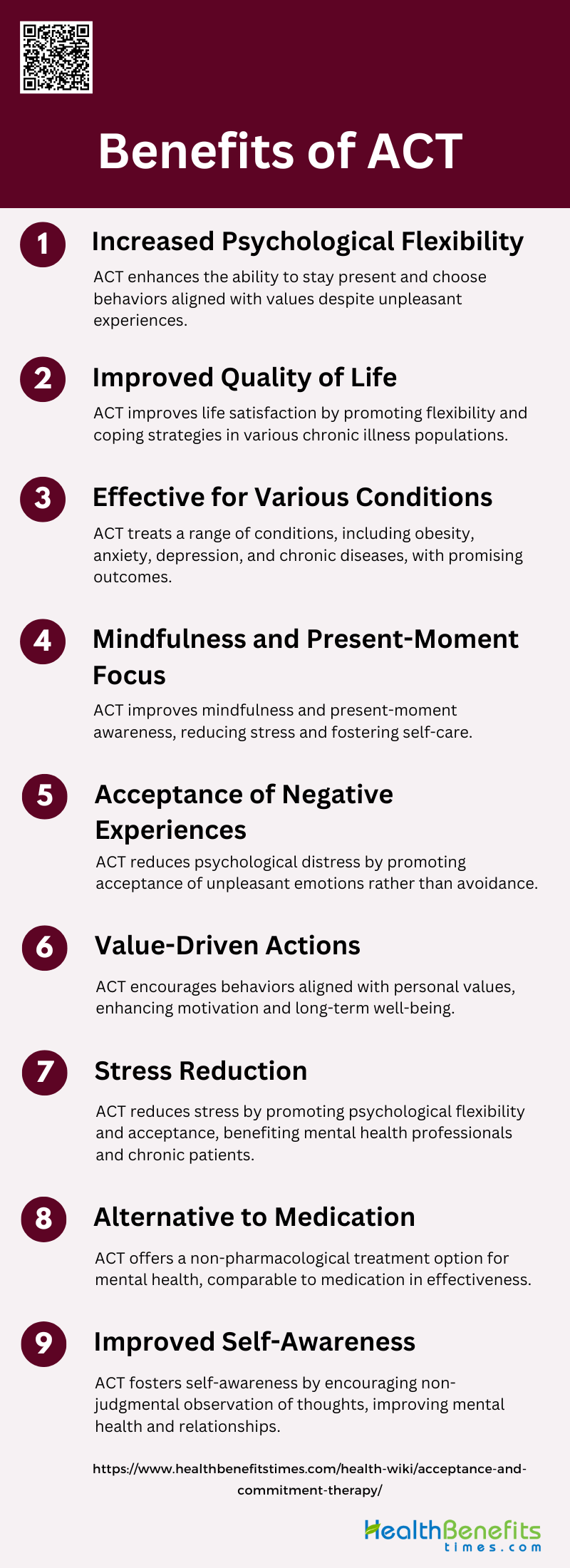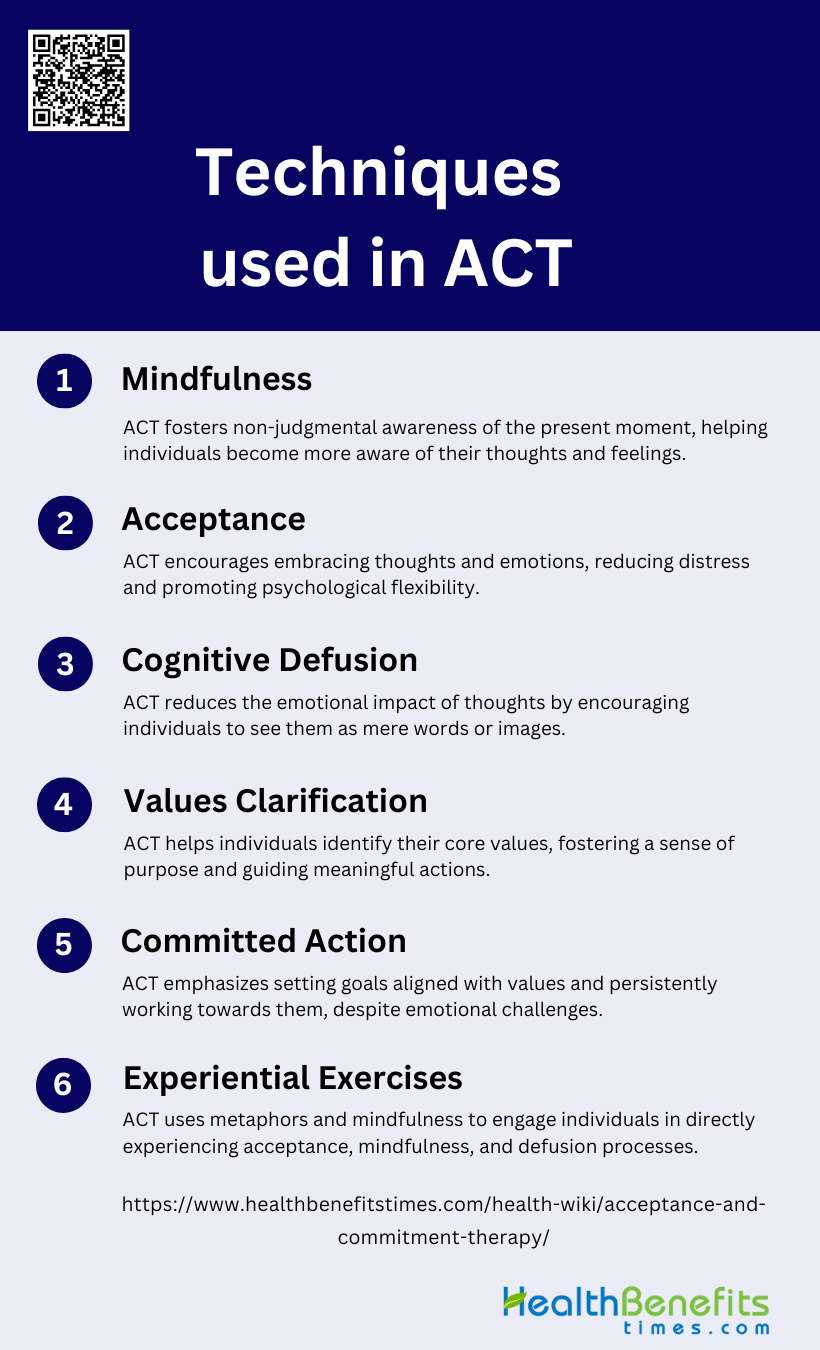Acceptance and Commitment Therapy (ACT) is a form of psychotherapy that falls under the umbrella of third-wave cognitive behavioral therapies. It aims to help individuals develop psychological flexibility by encouraging them to accept difficult thoughts and feelings while committing to behaviors aligned with their personal values. ACT emphasizes mindfulness techniques and focuses on six core processes: acceptance, cognitive defusion, being present, self as context, values, and committed action. This approach is designed to help people move towards a more meaningful and fulfilling life, rather than solely focusing on symptom reduction. ACT has shown effectiveness in treating various mental health issues, including depression, anxiety, and post-traumatic stress disorder, as well as addressing body dissatisfaction and gambling disorders.
Core Principles of ACT
Acceptance and Commitment Therapy (ACT) is a therapeutic approach designed to increase psychological flexibility. It emphasizes embracing thoughts and feelings while committing to actions aligned with personal values. Below are the Core Principles of ACT:
1. Acceptance
Acceptance is a fundamental principle of ACT that involves embracing one’s thoughts, feelings, and experiences without trying to change or avoid them. It encourages individuals to open up to unpleasant emotions and sensations, recognizing that struggling against them often leads to more suffering. Acceptance doesn’t mean resignation or giving up; rather, it’s about acknowledging reality as it is. Techniques to practice acceptance include mindfulness exercises, metaphors (like “leaves on a stream”), and experiential activities that help clients observe their internal experiences without judgment. By fostering acceptance, ACT aims to reduce the distress associated with difficult thoughts and feelings, allowing individuals to focus their energy on living a meaningful life aligned with their values.
2. Cognitive Defusion
Cognitive defusion is the process of creating psychological distance from one’s thoughts, reducing their impact and influence on behavior. It involves recognizing thoughts as mental events rather than absolute truths. This principle helps individuals to observe their thoughts without becoming entangled in them. Strategies to implement cognitive defusion include labeling thoughts (e.g., “I’m having the thought that…”), using metaphors (like thoughts as passengers on a bus), or visualizing thoughts as objects. These techniques aim to change one’s relationship with thoughts rather than attempting to alter their content or frequency. By practicing cognitive defusion, individuals can gain more flexibility in their responses to challenging thoughts and reduce their emotional impact.
3. Being Present
Being present, or mindfulness, is a core component of ACT that emphasizes awareness of the current moment without judgment. This principle encourages individuals to fully engage with their immediate experiences, rather than dwelling on the past or worrying about the future. Mindfulness in ACT helps people connect with their thoughts, feelings, and bodily sensations, fostering a deeper understanding of their internal experiences. Methods to enhance present moment awareness include guided mindfulness exercises, body scans, and mindful breathing techniques. By cultivating present-moment awareness, individuals can develop greater psychological flexibility, reduce stress, and improve their overall well-being.
4. Self-as-Context
Self-as-context, also known as the “observing self,” is a concept in ACT that refers to the part of oneself that is aware of thoughts, feelings, and experiences without being defined by them. It differs from self-concept, which is the collection of beliefs and ideas one has about oneself. Self-as-context encourages individuals to recognize that they are more than their thoughts and feelings; they are the conscious awareness that observes these experiences. This principle helps people develop a sense of continuity and stability amidst changing thoughts and emotions. Techniques to explore self-as-context include mindfulness exercises, metaphors (like the chessboard analogy), and experiential activities that highlight the distinction between the observer and the observed.
5. Values
Values in ACT are the qualities of action that individuals find meaningful and important in their lives. They serve as guiding principles for behavior and decision-making. Identifying personal values involves exploring what truly matters to an individual, beyond societal expectations or short-term gratification. ACT emphasizes the importance of clarifying values across various life domains, such as relationships, career, and personal growth. Techniques for identifying values include guided visualizations, writing exercises, and values card sorts. Linking values to actions is a crucial step in ACT, as it helps individuals align their behaviors with what they consider most important, leading to a more fulfilling and purposeful life.
6. Committed Action
Committed action in ACT involves setting goals and taking steps that are consistent with one’s identified values. This principle focuses on encouraging behavior change that moves individuals towards their valued directions, even in the face of obstacles or discomfort. Setting goals aligned with values involves breaking down larger aspirations into specific, achievable actions. ACT emphasizes the importance of persistence and flexibility in pursuing these goals, recognizing that setbacks are a normal part of the process. Techniques to promote committed action include developing SMART goals, creating action plans, and using behavioral activation strategies. By engaging in committed action, individuals can experience a greater sense of purpose and satisfaction in their lives.
How ACT Differs from Traditional Cognitive Behavioral Therapy (CBT)
Acceptance and Commitment Therapy (ACT) and traditional Cognitive Behavioral Therapy (CBT) share some similarities but differ in key aspects. While both approaches aim to improve mental health and well-being, ACT focuses more on accepting thoughts and feelings rather than changing them. Here are the main differences between ACT and traditional CBT:
1. Core Philosophy
Acceptance and Commitment Therapy (ACT) and Cognitive Behavioral Therapy (CBT) differ fundamentally in their core philosophies. ACT is rooted in the idea of psychological flexibility, emphasizing acceptance of thoughts and feelings rather than attempting to change them. It encourages individuals to live in accordance with their values despite the presence of negative emotions or thoughts. In contrast, CBT is based on the cognitive model, which posits that psychological distress is largely a result of dysfunctional thinking. CBT aims to identify, challenge, and change these maladaptive thoughts to improve emotional regulation and develop personal coping strategies.
2. Approach to Thoughts
ACT and CBT take distinct approaches to dealing with thoughts. ACT employs a strategy called cognitive defusion, which helps individuals see their thoughts as mere mental events rather than truths that dictate their behavior. This approach reduces the power of negative thoughts by promoting acceptance and mindfulness. On the other hand, CBT focuses on cognitive restructuring, which involves identifying and challenging distorted or irrational thoughts and replacing them with more realistic and balanced ones. This method aims to directly alter the content of thoughts to reduce emotional distress and maladaptive behavior.
3. Treatment Goals
The treatment goals of ACT and CBT also differ significantly. ACT aims to increase psychological flexibility, enabling individuals to act in ways that are consistent with their values even in the presence of difficult thoughts and feelings. The ultimate goal is to help individuals lead a meaningful and fulfilling life. Conversely, CBT aims to reduce symptoms of psychological distress by changing maladaptive thought patterns and behaviors. The primary goal is symptom relief and the development of healthier thinking and behavior patterns.
4. Duration and Focus
The duration and focus of ACT and CBT can vary, but both therapies are typically structured and time-limited. ACT often involves a focus on experiential exercises and mindfulness practices to foster acceptance and commitment to values-based actions. CBT, however, tends to be more focused on skill-building and homework assignments that target specific cognitive and behavioral changes. Both therapies usually span several weeks to months, but the specific duration can depend on the individual’s needs and the severity of their symptoms.
5. Role of Acceptance
Acceptance plays a central role in ACT but is less emphasized in traditional CBT. In ACT, acceptance is seen as a crucial component for dealing with unwanted thoughts and feelings. It involves embracing these experiences without trying to change them, thereby reducing their impact on behavior. In contrast, CBT focuses more on changing and controlling thoughts and emotions rather than accepting them. While some modern CBT approaches have incorporated elements of acceptance, it is not as foundational as it is in ACT.
6. Therapeutic Techniques
ACT and CBT employ different therapeutic techniques. ACT uses mindfulness exercises, values clarification, and commitment strategies to help individuals accept their internal experiences and commit to value-driven actions. Techniques such as cognitive defusion and experiential exercises are commonly used. CBT, on the other hand, utilizes techniques like cognitive restructuring, behavioral activation, and exposure therapy to change maladaptive thoughts and behaviors. Homework assignments and skill-building exercises are integral parts of CBT.
7. Perspective on Discomfort
ACT and CBT have different perspectives on discomfort. ACT encourages individuals to accept discomfort as a natural part of life and to continue pursuing meaningful activities despite it. This approach aims to reduce the struggle with discomfort and increase psychological flexibility. In contrast, CBT aims to reduce discomfort by changing the thoughts and behaviors that contribute to it. The focus is on alleviating symptoms and improving emotional regulation through cognitive and behavioral interventions.
Benefits of ACT
Acceptance and Commitment Therapy (ACT) offers numerous benefits for individuals seeking to improve their mental health and overall well-being. This therapeutic approach has shown effectiveness in treating a wide range of psychological issues and promoting personal growth. Some of the key benefits of ACT include:
1. Increased Psychological Flexibility
Acceptance and Commitment Therapy (ACT) is renowned for its ability to enhance psychological flexibility, which is the capacity to stay in contact with the present moment regardless of unpleasant thoughts, feelings, and bodily sensations, while choosing one’s behavior based on the situation and personal values. Studies have shown that ACT interventions significantly improve psychological flexibility across various populations, including those with chronic diseases and mental health conditions. This improvement is often mediated by the core processes of ACT, such as acceptance, cognitive defusion, and committed action, which collectively help individuals adapt to changing circumstances and reduce psychological distress.
2. Improved Quality of Life
ACT has been shown to significantly enhance the quality of life in various patient groups, including those with chronic illnesses and cancer. By promoting psychological flexibility, ACT helps individuals better manage their symptoms and stress, leading to improved overall well-being. For instance, a meta-analysis revealed that ACT interventions led to significant improvements in quality of life among cancer patients, highlighting the therapy’s potential to alleviate the psychological burden associated with chronic conditions. These findings suggest that ACT can be a valuable tool in improving life satisfaction and emotional well-being.
3. Effective for Various Conditions
ACT has demonstrated efficacy across a wide range of conditions, including obesity, inflammatory bowel diseases, and mental health issues such as anxiety and depression. For example, ACT has been effective in reducing stress and improving psychological health in patients with Crohn’s disease and ulcerative colitis. Additionally, ACT has been successfully applied to enhance mental health in individuals with mild to moderate psychological distress, showing improvements in emotional and psychological well-being. This versatility makes ACT a robust therapeutic approach for diverse clinical populations.
4. Mindfulness and Present-Moment Focus
Mindfulness and present-moment awareness are core components of ACT, which help individuals focus on the here and now rather than getting caught up in past regrets or future anxieties. Research indicates that ACT interventions improve mindfulness, which in turn enhances psychological flexibility and reduces stress. For instance, a systematic review found that ACT, along with other mindfulness-based interventions, effectively fosters self-care and reduces burnout among mental health professionals, underscoring the importance of present-moment focus in managing stress and promoting well-being.
5. Acceptance of Negative Experiences
ACT encourages the acceptance of negative experiences rather than avoiding or suppressing them. This acceptance is crucial for reducing psychological distress and improving mental health outcomes. Studies have shown that ACT interventions lead to significant reductions in stress, anxiety, and depression by promoting acceptance of unpleasant thoughts and feelings. For example, in patients with inflammatory bowel diseases, ACT was associated with reduced perceived stress and depression, highlighting the therapeutic value of acceptance in managing chronic conditions.
6. Value-Driven Actions
A key aspect of ACT is helping individuals identify and commit to actions that align with their personal values. This value-driven approach enhances motivation and provides a sense of purpose, which is essential for long-term behavior change and psychological well-being. Research has demonstrated that ACT interventions improve value-based behavior, leading to better mental health and quality of life. For instance, a study on obesity management found that focusing on values-oriented behaviors significantly contributed to the maintenance of a healthy lifestyle.
7. Stress Reduction
ACT is effective in reducing stress by promoting psychological flexibility and acceptance. Studies have shown that ACT interventions lead to significant reductions in stress levels among various populations, including patients with chronic diseases and mental health professionals. For example, a randomized controlled trial found that ACT significantly reduced stress symptoms in patients with inflammatory bowel diseases, demonstrating the therapy’s potential to alleviate stress-related psychological dysfunction. Additionally, ACT has been shown to reduce burnout and stress in mental health professionals, further supporting its stress-reducing benefits.
8. Alternative to Medication
ACT offers a viable alternative to medication for managing psychological distress and improving mental health. By focusing on psychological flexibility and acceptance, ACT provides non-pharmacological strategies to cope with stress, anxiety, and depression. Research has shown that ACT can be as effective as medication in some cases, providing a complementary or alternative treatment option for individuals seeking non-drug interventions. For instance, ACT has been found to improve psychological flexibility and reduce distress in patients with chronic conditions, offering a holistic approach to mental health care.
9. Improved Self-Awareness
ACT enhances self-awareness by encouraging individuals to observe their thoughts, feelings, and behaviors without judgment. This increased self-awareness is crucial for making informed decisions and engaging in value-driven actions. Studies have shown that ACT interventions improve mindfulness and self-awareness, leading to better mental health outcomes. For example, a meta-analysis found that higher levels of psychological flexibility, which includes self-awareness, were linked to better relationship satisfaction and lower parenting stress, highlighting the broader benefits of improved self-awareness.
Techniques Used in ACT
Acceptance and Commitment Therapy (ACT) employs several key techniques to help individuals develop psychological flexibility and improve their overall well-being. These techniques work together to create a comprehensive approach to mental health and personal growth. The main techniques used in ACT include:
1. Mindfulness
Mindfulness in Acceptance and Commitment Therapy (ACT) involves fostering a non-judgmental awareness of the present moment. This technique helps individuals become more aware of their thoughts, feelings, and bodily sensations without becoming entangled in them. Studies have shown that mindfulness can improve psychological flexibility, which is a core aim of ACT. For instance, a systematic review found that internet-based ACT (ACT) had small effects on mindfulness at the immediate posttest, supporting its role in enhancing psychological flexibility. Additionally, mindfulness-based interventions have been effective in reducing stress and burnout among mental health professionals, further validating its utility in therapeutic settings.
2. Acceptance
Acceptance is a fundamental component of ACT, encouraging individuals to embrace their thoughts and feelings rather than fighting or avoiding them. This approach aims to reduce the struggle with negative emotions and increase psychological flexibility. Research has demonstrated that acceptance-based interventions can be effective in various contexts, including weight management and stress reduction. For example, a study on ACT for obesity management highlighted the importance of acceptance in promoting a healthy lifestyle and improving psychological well-being. Another meta-analysis found that ACT had a moderate effect on psychological flexibility among family caregivers, emphasizing the role of acceptance in coping with caregiving stress.
3. Cognitive Defusion
Cognitive defusion techniques in ACT aim to change the way individuals interact with their thoughts, reducing their impact and believability. This is achieved through exercises that help individuals see thoughts as mere words or images rather than absolute truths. Experimental studies have explored various defusion exercises, such as word repetition, to understand their effectiveness. However, results have been mixed, with some studies failing to show significant changes in emotional assessment. Despite this, cognitive defusion remains a key process in ACT, helping individuals reduce the distress associated with negative thoughts, as seen in interventions for social anxiety.
4. Values Clarification
Values clarification in ACT involves helping individuals identify and connect with their core values, which serve as a guide for meaningful action. This process is crucial for fostering a sense of purpose and direction in life. Research has shown that values-oriented behaviors can significantly impact treatment outcomes. For instance, a study on ACT for obesity management found that values clarification was essential for promoting long-term adherence to a healthy lifestyle. Additionally, values-directed action has been used effectively in couple therapy to help partners act in ways consistent with their relationship values, improving marital satisfaction.
5. Committed Action
Committed action in ACT refers to taking concrete steps towards living in alignment with one’s values, even in the presence of difficult thoughts and feelings. This process involves setting goals and persistently working towards them. Studies have shown that committed action is a critical component of ACT, contributing to improved psychological flexibility and well-being. For example, a meta-analysis found that ACT had a small effect on valued living, which includes committed action, at the immediate posttest. In the context of PTSD treatment, committed action has been linked to better quality of life and reduced symptom severity.
6. Experiential Exercises
Experiential exercises in ACT are designed to help individuals directly experience the processes of acceptance, mindfulness, and cognitive defusion. These activities often involve metaphors, mindfulness practices, and role-playing scenarios. Research has highlighted the effectiveness of experiential exercises in various populations, including those with learning disabilities. A case study demonstrated that ACT-based experiential activities helped a young person with learning disabilities manage anxious and obsessive thoughts, suggesting that these exercises can be more accessible and impactful than traditional cognitive-behavioral techniques. Additionally, experiential exercises have been adapted for use in couple therapy, showing promise in improving relationship dynamics.
Practical Applications of ACT
Acceptance and Commitment Therapy (ACT) has demonstrated its effectiveness in addressing a wide range of psychological issues and improving overall well-being. Its versatile approach makes it applicable to various contexts and populations. Some of the practical applications of ACT include:
1. Mental Health Disorders
Acceptance and Commitment Therapy (ACT) has shown significant efficacy in treating various mental health disorders, including depression and generalized anxiety disorder (GAD). A randomized controlled trial demonstrated that a two-session ACT protocol focused on disrupting repetitive negative thinking was highly effective in reducing emotional symptoms in individuals with depression and GAD. The intervention led to clinically significant changes in 94.12% of participants, with effects maintained at a three-month follow-up. Additionally, meta-analyses have confirmed that ACT is more effective than waitlist controls and treatment as usual, and it is comparable to traditional cognitive behavioral therapy (CBT) in treating anxiety and depression.
2. Chronic Pain and Illness Management
ACT has been increasingly applied to manage chronic diseases and long-term conditions. A systematic review highlighted the potential of ACT to improve quality of life, symptom control, and reduce distress across various chronic conditions such as HIV, cancer, and epilepsy. Although the quality of studies varied, there was promising evidence supporting the use of ACT in enhancing psychological flexibility and disease self-management. This suggests that ACT can be a valuable tool in the holistic management of chronic illnesses, helping patients to live more fulfilling lives despite their conditions.
3. Applications in Addiction Therapy
ACT has also been explored as a treatment for substance use disorders. Meta-analytic evidence indicates that ACT is effective in treating addiction, showing superiority over waitlist controls and treatment as usual. The therapy’s focus on increasing psychological flexibility and reducing experiential avoidance helps individuals to better manage cravings and reduce substance use. By fostering acceptance and commitment to personal values, ACT aids in breaking the cycle of addiction and promoting long-term recovery.
4. Stress and Burnout
ACT has been utilized to address stress and burnout, particularly in high-stress environments such as universities. A randomized controlled trial involving university students found that a web-based ACT intervention significantly improved mental health outcomes, including reductions in depression, anxiety, and stress, while enhancing well-being and life satisfaction. These improvements were mediated by key ACT processes such as acceptance and cognitive defusion, and were maintained at a 12-week follow-up4. This demonstrates the potential of ACT to mitigate stress and prevent burnout by promoting psychological resilience.
5. Life Transitions and Personal Growth
ACT is effective in facilitating personal growth and managing life transitions. The therapy’s emphasis on values-based living and psychological flexibility helps individuals navigate significant life changes, such as transitioning to adulthood or coping with subthreshold depressive and psychotic symptoms. A study on emerging adults showed that ACT, augmented with daily life applications, was feasible and led to significant reductions in interviewer-rated depression scores. This indicates that ACT can support individuals in adapting to new life circumstances and fostering personal development.
6. Behavioral Change
ACT is widely used to promote behavioral change by helping individuals align their actions with their values. The therapy’s focus on acceptance and commitment to valued actions has been shown to be effective in various contexts, including improving mental health and well-being through web-based interventions. A systematic review and meta-analysis found that web-delivered ACT interventions were effective in managing depression and had high adherence rates, suggesting that this approach is both effective and acceptable to the general public. This highlights ACT’s versatility in facilitating meaningful behavioral changes across different delivery formats and populations.
Common Misconceptions about ACT
Despite its growing popularity and effectiveness, Acceptance and Commitment Therapy (ACT) is sometimes misunderstood or misinterpreted. These misconceptions can lead to confusion about the therapy’s goals and methods. Some common misconceptions about ACT include:
1. ACT seeks unrealistically high goals or makes grandiose claims.
Acceptance and Commitment Therapy (ACT) does not seek unrealistically high goals or make grandiose claims. Instead, it focuses on helping individuals accept their thoughts and feelings rather than fighting or feeling guilty for them. ACT aims to increase psychological flexibility, allowing individuals to live a life aligned with their values despite the presence of difficult emotions or thoughts. Studies have shown that ACT can effectively reduce stress, anxiety, and depression by fostering mindfulness and acceptance, rather than promising unattainable outcomes.
2. ACT only works for well-educated people.
The effectiveness of ACT is not limited to well-educated individuals. Research has demonstrated its applicability across diverse populations, including college students, parents of children with developmental disabilities, and individuals with chronic pain or mental health issues. For instance, web-based ACT interventions have been successfully used to address mental health problems in college students, showing improvements in overall distress, anxiety, and depression. This indicates that ACT can be adapted to various educational backgrounds and settings.
3. ACT only works for white middle-class Americans.
ACT is a transdiagnostic approach that has been shown to be effective across different demographic groups, not just white middle-class Americans. Studies have included diverse populations, such as veterans with chronic pain and individuals with psychosis and trauma histories, demonstrating significant improvements in mental health outcomes. The flexibility and adaptability of ACT make it suitable for various cultural and socioeconomic backgrounds, challenging the misconception that it is only effective for a specific demographic.
4. ACT is against exposure therapy.
Contrary to the misconception that ACT is against exposure therapy, ACT actually incorporates exposure techniques as part of its approach. The therapy encourages individuals to face their fears and anxieties in a mindful and accepting manner, which is a form of exposure. For example, ACT has been used effectively to treat anxiety disorders by helping individuals accept their anxious thoughts and feelings while engaging in valued actions. This integration of exposure within the ACT framework highlights its compatibility with traditional exposure therapy methods.
5. ACT is not a mindfulness-based therapy.
ACT is indeed a mindfulness-based therapy. It incorporates mindfulness practices to help individuals become more aware of their thoughts and feelings without judgment. This mindfulness component is crucial for increasing psychological flexibility and promoting valued living. Research has consistently shown that ACT improves mindfulness and acceptance, which are key processes in the therapy. The integration of mindfulness within ACT distinguishes it as a mindfulness-based intervention, contrary to the misconception that it is not.
FAQs
1. How does ACT handle trauma or past negative experiences?
While ACT doesn’t focus on reprocessing past trauma in the way some therapies do (like EMDR), it helps individuals accept their difficult thoughts and feelings related to trauma without letting them control their present actions. This acceptance, coupled with value-based actions, allows individuals to move forward in life without being defined by their past experiences.
2. Can ACT be used for people with severe mental health disorders?
Yes, ACT has been applied successfully to individuals with severe mental health issues such as schizophrenia, bipolar disorder, and chronic depression. The therapy helps individuals gain a new perspective on their thoughts and symptoms, enabling them to commit to actions that align with their values despite their struggles.
3. What makes ACT different from other mindfulness-based therapies like Mindfulness-Based Cognitive Therapy (MBCT)?
While both ACT and MBCT incorporate mindfulness practices, ACT emphasizes accepting unwanted thoughts and emotions while committing to actions aligned with personal values. MBCT, on the other hand, focuses more on preventing the relapse of depression through mindful awareness of thoughts and emotions.
4. Can ACT be combined with medication?
Yes, ACT can complement medication-based treatments. It helps individuals manage symptoms and improve psychological flexibility, making it easier for them to adhere to medication routines and cope with side effects.
5. How does ACT handle resistance to change?
Instead of pushing for change, ACT helps individuals understand and accept their resistance. By encouraging them to focus on their values and the present moment, it helps them make committed changes in their behavior when they are ready.
6. Is ACT suitable for children or adolescents?
Yes, ACT can be adapted for younger populations. It has been used effectively with children and adolescents to address issues like anxiety, behavioral problems, and difficulties with emotional regulation, helping them develop psychological flexibility early on.
7. How long does ACT therapy usually last?
ACT is often a short to medium-term therapy, with many clients seeing significant improvements within 8 to 12 sessions. However, the duration can vary based on the individual’s specific needs and goals.
8. Can ACT help with procrastination or motivational issues?
Yes, ACT’s focus on committed action and value-based living can help individuals overcome procrastination. By connecting daily actions to deeply held personal values, it can increase motivation and decrease avoidance behaviors.
9. Is ACT useful for people without a mental health diagnosis?
ACT is not only for individuals with mental health diagnoses; it can be highly effective for personal growth, improving life satisfaction, handling life transitions, and enhancing overall well-being.
10. How is progress measured in ACT therapy?
Progress in ACT is often measured by an individual’s increased psychological flexibility, ability to act in alignment with their values, and decreased avoidance of uncomfortable thoughts and feelings rather than just a reduction in symptoms.







